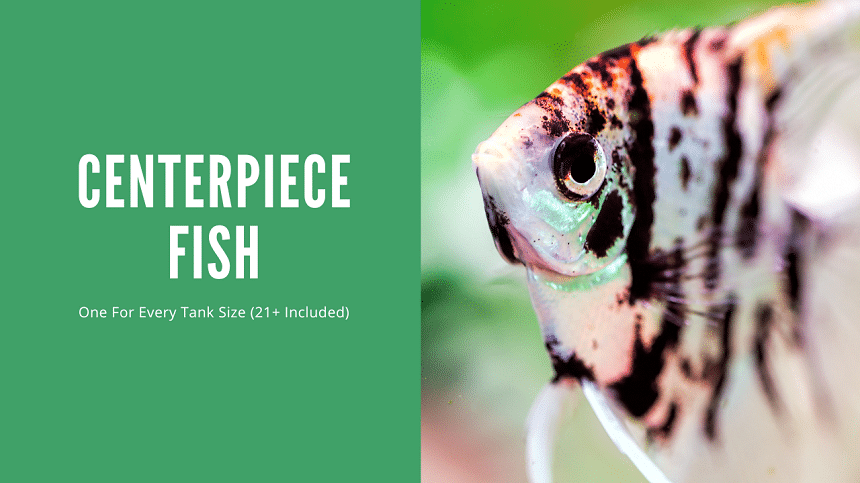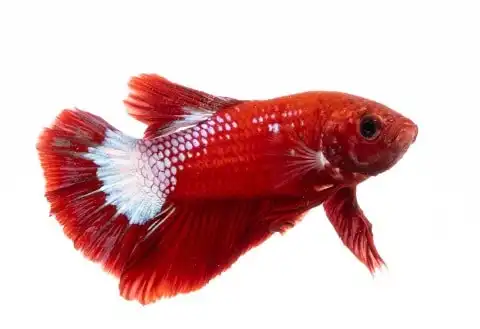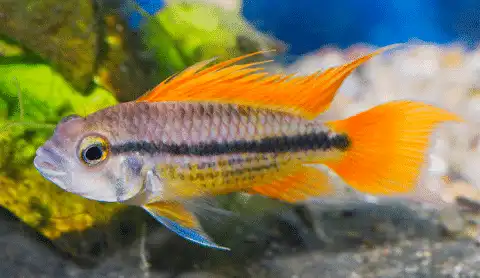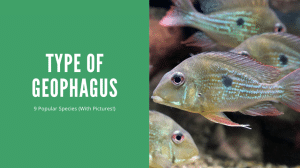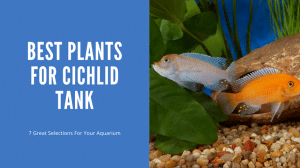Thank you for visiting! By the way… any links on this page that lead to products on Amazon and other stores/partners are affiliate links Aquarium Store Depot earns a commission if you make a purchase.
Are you looking for a showstopping centerpiece fish to add to your community aquarium? Well, you’ve come to the right place! This article introduces over 20 stunning centerpiece fish for your freshwater aquarium.
In this guide, I’ll cover everything from nano fish for 5-gallon tanks to foot-long fish for large aquariums, and there are also loads of handy tips for choosing the perfect species for your community.
Let’s get started!
Key Takeaways
- The best centerpiece fish are eyecatching species that get along peacefully with other tank mates
- Each fish species prefers different water parameters, so choose a species that will be comfortable in your local water
- Research the needs and adult size of any fish before having it bagged at your local fish store. Most fish are sold when they are very young
- Avoid aggressive species unless you plan on keeping them in a species-only tank or with other aggressive fish
What Are They?
Have you ever looked into a fish tank and immediately noticed one fish that really stands out above all of its tank mates? Well, that’s a centerpiece fish! They are usually bigger, brighter, or even stranger than the other species, and they are always the main talking point of the tank.
Centerpiece fish aren’t only for community tanks, either. Many aquarists prefer to keep just one centerpiece species in its own tank. Wondering how to choose the perfect centerpiece fish for your aquarium? Read on to find out!
How to Choose the Right Species for Your Tank
Choosing a good centerpiece fish for your tank requires you to ask a few questions. Firstly, Are you looking for a new fish for a community tank? If so, it’s very important that your new pet gets along with all its companions.
Consider the following factors to make a smart choice:
Size
Centerpiece fish are usually larger than the other fish in their tank, creating a pretty obvious problem. Big fish eat little fish, so how do you prevent your fishy friends from turning into snacks?
- Choose species with small mouths. Most fish will swallow anything they can fit in their mouths, so predatory fish with huge mouths are a big no-no.
- Choose species that are similar-sized or just a little larger than their tank mates.
Their size will also determine the tank size you need. For ease, I have included several categories when classifying these fish so you know where they fit in your aquarium size. They are:
- Small – 5 – 20 gallons
- Medium – 29 – 55 gallons
- Large – 60 gallons and up
Temperament
Choose peaceful fish unless you’re setting up a species-only aquarium where your centerpiece fish will have the tank all to itself. Some fish are most peaceful when kept alone, while others need the company of their own species to stay healthy and confident.
Water Parameters
Freshwater fish are found in lakes, rivers, and swamps worldwide. However, the chemical properties of the water where they live can differ pretty dramatically from one place to another, and some fish are specifically adapted to certain conditions.
- Choose fish that prefer similar pH and water hardness. Most species do well in neutral water, but some, like the West African cichlids, need hard, high-pH water to thrive. It’s always best to choose fish that will be comfortable in the kind of water you already have.
- Temperature is very important too. Most tropical fish thrive in water in the mid-70s Fahrenheit, but some species need water above 80 degrees to survive long-term. Those species just aren’t going to work with something like a goldfish that prefers water in the upper 60s or lower 70s.
The 21 Best Centerpiece Fish
Now that you know what a centerpiece fish is and some of the most important factors for choosing the right species, let’s go ahead and meet some amazing species that could be the next star of your tank! We have an excellent video from our YouTube channel if you would like to follow along. Our blog post goes into further detail as well. Subscribe if you like our content, as we post new videos every week.
Small (5 – 20 gallons)
Starting out our list with fish that are best for nano tanks. These can either be housed alone or with other fish.
1. Betta
Use Coupon Code ASDFISH at Checkout
Betta Fish are one of the most beautiful varieties of freshwater fish available in the hobby. Easy to care for with plenty of varieties!
- Scientific Name: Betta splendens
- Size: 2.5 inches
- Minimum Tank Size: 5 gallons
- Water Temperature: 76 – 80 °F
- pH: 6 – 8
- Hardness requirements: 5 – 20 dGH
- Diet: Carnivorous
If you’re looking for a colorful species for a nano aquarium then look no further than the betta fish! No other centerpiece fish comes in such an amazing color variation, scale types, and fin shapes.
Also known as the Siamese fighting fish, this colorful fish is the number one choice if you have a five-gallon aquarium. However, at that size, you’d want to give your betta the tank all to itself.
That doesn’t mean you can’t set up a giant betta fish tank with loads of other peaceful fish! This popular labyrinth fish actually makes an excellent centerpiece fish in a tropical community tank.
2. Apistogramma Dwarf Cichlids
These dwarf cichlids make excellent centerpiece fish in smaller tanks. Gets along with many types of community fish
- Scientific Name: Apistogramma spp.
- Size: 3 – 3.5 inches
- Minimum Tank Size: 15 gallons
- Water Temperature: 72 – 84 °F
- pH: 6 – 7
- Hardness requirements: 6 – 10 dGH
- Diet: Carnivorous
Apistogrammas are dwarf cichlids from South America with great colors and interactive nature. There are many species to choose from, including the popular Apistogramma agassizii and Apistogramma cacatuoides.
You could keep these territorial fish with a group of small schooling fish like neon tetras in a 15-gallon or larger aquarium or you can step down to a ten-gallon and keep a breeding pair of Apistogrammas on their own.
3. Bolivian Ram
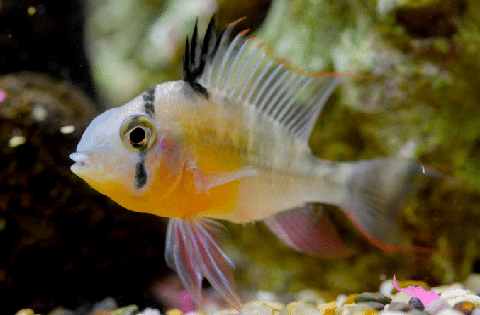
- Scientific Name: Mikrogeophagus altispinosus
- Size: 3 inches
- Minimum Tank Size: 20 gallon aquarium
- Water Temperature: 77 – 82 °F
- pH: 6 – 7.5
- Hardness requirements: 6 – 14 dGH
- Diet: Omnivorous
Bolivian Rams are another great choice for a smaller tank. These dwarf cichlids tend to hang out at the bottom of the aquarium, where they add a splash of color to your community tank.
Cichlids have a reputation for aggression, but this peaceful fish species will get along perfectly with other peaceful schooling fish. It is considered one of the best community fish you can purchase in this size range.
4. Dwarf Gourami

- Scientific Name: Trichogaster lalius
- Size: 2.5 – 3 inches
- Minimum Tank Size: 15 – 20 gallons
- Water Temperature: 72 – 82 °F
- pH: 6 – 7.5
- Hardness requirements: 10 – 20 dGH
- Diet: Omnivorous
The dwarf gourami is one of my favorite centerpiece fish for smaller aquariums. This species is available in various color morphs, including the stunning powder blue gourami and the bright orange flame gourami.
These popular aquarium fish are great for a community tank, although dwarf gouramis are not the best tankmates for shy fish in the same aquarium because they can get a little boisterous around meal times.
5. Kribensis Dwarf Cichlids
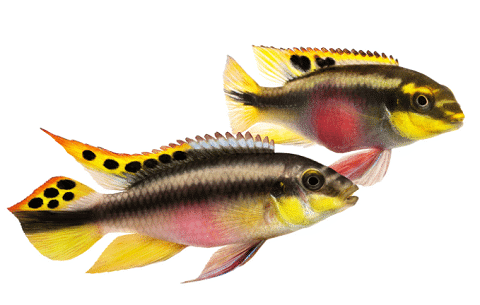
- Scientific Name: Pelvicachromis pulcher
- Size: 3 – 4 inches
- Minimum Tank Size: 20 gallons
- Water Temperature: 75 – 81 °F
- pH: 5 – 7.5
- Hardness requirements: 5 – 20 dGH
- Diet: Omnivorous
The kribensis is another dwarf cichlid species, this time from the tropical rivers of West Africa. Kribensis cichlids combine beautiful red, yellow, and orange colors with bold black stripes and spots.
They do not require hard, alkaline water like East African cichlids so these colorful fish can be kept with a wide variety of other community fish. This species generally has a peaceful nature, but they can become aggressive when breeding, especially if kept in a small community tank. To keep with aggression, consider housing them in a 20 gallon long tank instead of a standard 20 gallon tank to give them enough space to maintain territory.
6. Honey Gourami
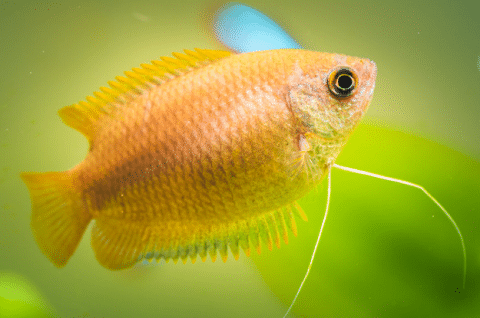
- Scientific Name: Trichogaster chuna
- Size: 2 inches
- Minimum Tank Size: 15 gallons
- Water Temperature: 72 – 80 °F
- pH: 6 – 7.5
- Hardness requirements: 2 – 15 dGH
- Diet: Carnivorous
Honey gouramis are the smaller and more peaceful relative of the dwarf gourami. They are especially colorful during the breeding season, but even when they’re not super colorful, these fish still stand out with an interesting body shape and strange arm-like pelvic fins.
Honey Gouramis are the ideal centerpiece fish for a nano community tank because they get along great with smaller schooling fish like neon tetras and bottom dwellers like cory cats.
7. Splendid Killifish
- Scientific Name: Aphyosemion splendopleure
- Size: 2 inches
- Minimum Tank Size: 10 gallon tank
- Water Temperature: 72 – 78 °F
- pH: 6 – 7.2
- Hardness requirements: 3 – 15 dGH
- Diet: Carnivore
The male splendid killifish (video source) definitely lives up to its name with bright colors and fancy fins, although females have more understated colors. These West African nano fish are great for fish keepers who want something a little more unusual and rare for their tank.
These small fish can be a little shy, so set them up in a well-planted tank with plenty of floating plants and low powered aquarium lights to simulate their natural environment and keep them happy and confident.
8. German Rams
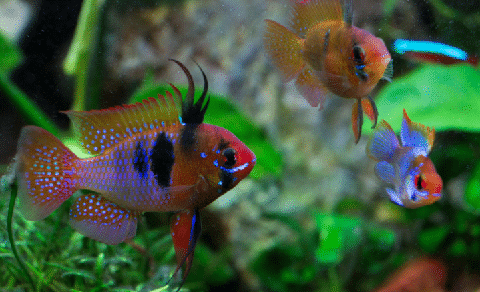
- Scientific Name: Mikrogeophagus ramirezi
- Size: 1.5 inches
- Minimum Tank Size: 15 gallons
- Water Temperature: 80 – 86 °F
- pH: 4 – 7
- Hardness requirements: 6 – 14 dGH
- Diet: Omnivorous
The German blue ram is a tropical fish from South America and not from Germany, in case you were wondering. This neon-colored dwarf cichlid is a great choice for experienced fish keepers looking for a great centerpiece fish in a small to medium-sized aquarium. Take note that German Blue Ram fish need relatively high water temperatures, which counts out a few of the more common community tank mates. They are also considered a more advanced fish to care for as they are more sensitive than many of the fish on this list.
9. Scarlet Badis
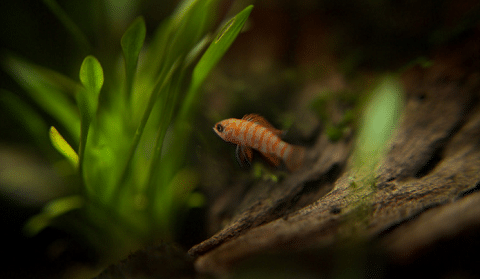
- Scientific Name: Dario dario
- Size: 0.5 – 0.75 inches
- Minimum Tank Size: 10 gallons
- Water Temperature: 65 – 78 °F
- pH: 6.5 – 8.5
- Hardness requirements: 10 – 20 dGH
- Diet: Carnivorous
The scarlet badis is a true nano species and one of the smallest fish in the aquarium hobby! You could keep these micro fish in a tank of just 5 gallons, but maintaining high water quality will be much easier in a larger setup.
These guys can be a little tricky to care for because they prefer live food like daphnia and micro worms. However, if you’re willing to make the effort, these adorable fish can be fascinating centerpiece fish for a well-planted nano tank, especially if kept with other nano fish like celestial pearl danios or chili rasboras.
Medium (29 – 55 Gallons)
The next step up is the 29-55 gallon range. Here we can get more creative with our choices and keep some really showcase fish.
1. Freshwater Angelfish

- Scientific Name: Pterophyllum scalare
- Size: 6 inches long and 8 inches tall
- Minimum Tank Size: 29 gallons
- Water Temperature: 76 – 86 °F
- pH: 6 – 7.4
- Hardness requirements: 4 – 12 dGH
- Diet: Omnivorous
Freshwater angelfish have earned their position as one of the most popular aquarium fish in the hobby. These South American Cichlids are the perfect centerpiece fish because they have great colors and a unique and dramatic body shape.
Despite their impressive size, angelfish have very small mouths, so they can be kept with smaller fish like black skirt tetras and a few small algae eaters like otocinclus catfish. However, they are not too small to snack on smaller species like the neon tetra, so keep that in mind when choosing other tank mates.
2. Pearl Gourami

- Scientific Name: Trichopodus leerii
- Size: 4 – 4.5 inches
- Minimum Tank Size: 29 gallons
- Water Temperature: 75 – 86 °F
- pH: 5.5 – 8
- Hardness requirements: 5 – 15 dGH
- Diet: Omnivorous
The pearl gourami is a highly underrated centerpiece fish for medium-sized sized fish tanks. Males are more colorful than females, but both sexes have an amazing pearl-spotted pattern.
Pearl gouramis are very peaceful fish and their tolerance for a wide pH range makes than a great tank mate for everything from the cardinal tetra to a group of fancy guppies (such as cobra guppies).
3. Sajica Cichlid
- Scientific Name: Cryptoheros sajica
- Size: 5 inches
- Minimum Tank Size: 29 gallons
- Water Temperature: 75 – 82°F
- pH: 7 – 8
- Hardness requirements: 7 – 15 dGH
- Diet: Omnivorous
The sajica or T-bar cichlid (video source) is an awesome Central American cichlid that makes a great centerpiece fish for a medium-sized aquarium. These river-dwellers have a chunky rounded body-shape and males in particular have full flowing fins.
Like many other cichlids, they will get a little aggressive when breeding. You could keep a pair of these interesting fish in their own tank or try a single male in a larger tank with a school of fish like like larger tetras and some bottom dwellers like corydoras catfish.
4. Red Irian Rainbowfish

- Scientific Name: Glossolepis incisus
- Size: 6 inches
- Minimum Tank Size: 55 gallons
- Water Temperature: 72 – 77 °F
- pH: 7 – 8
- Hardness requirements: 10 – 20 dGH
- Diet: Omnivorous
The red Irian rainbowfish is a fish that turns heads. These humpbacked schooling fish have a deep scarlet-red body color with scattered silvery scales from their head to their tail.
Red Irian rainbowfish usually stick to the mid and upper layers of your fish tank and will get along with other peaceful community fish. You will need a school of at least 6 of these active fish to see them at their confident best.
5. Hemichromis exsul
- Scientific Name: Hemichromis/ Rubricatochromis exsul
- Size: 4 inches
- Minimum Tank Size: 29 gallons
- Water Temperature: 73 – 80°F
- pH: 7 – 8
- Diet: Omnivorous
The Turkana jewel cichlid is a semi-aggressive East African cichlid with some of the most amazing colors in the hobby (video source). These small cichlids will brighten up any tank with their deep red color and neon blue spots.
They are relatively peaceful as far as jewel cichlids go, but you’ll still need to choose their tank mates carefully since they can get pretty feisty when breeding.
Large (60 gallons and up)
Now we get to the big show stoppers. 4 foot tank minimums are required here. These are all standout fish that will be the topic of conversations with your house guests.
1. Electric Blue Acara

- Scientific Name: Andinoacara pulcher
- Size: 5 – 6 inches
- Minimum Tank Size: 40+ gallons
- Water Temperature: 72 – 82 °F
- pH: 6.5 – 8
- Hardness requirements: 6 – 20 dGH
- Diet: Carnivorous
The electric blue acara is an excellent centerpiece fish for hobbyists with larger tanks. If you want a species that gets people talking, choose this neon blue South American cichlid!
These fish are diggers, so keep that in mind when planning your fish tank layout. Live plants are recommended but stick to epiphytes like anubias and java moss that you can anchor to a sturdy piece of driftwood or rockwork.
2. Discus
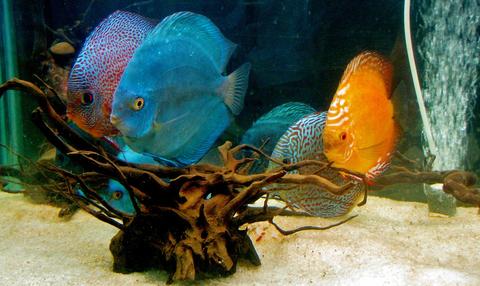
- Scientific Name: Symphysodon aequifasciatus
- Size: 5 – 6 inches
- Minimum Tank Size: 55 gallons
- Water Temperature: 84 – 86 °F
- pH: 6 – 7
- Hardness requirements: 2 – 8 dGH
- Diet: Carnivorous
The discus fish is arguably THE centerpiece showstopper fish in the entire aquarium hobby. These dinner plate-shaped cichlids boast some of the most exquisite colors in the whole animal kingdom!
Discus fish are not recommended for beginners. They require excellent water quality, and they need warmer water than most species, which limits their tank mate selection.
3. Geophagus Sveni
- Scientific Name: Geophagus sveni
- Size: 9 inches
- Minimum Tank Size: 75 gallons
- Water Temperature: 76 – 84 °F
- pH: 6 – 7
- Hardness requirements: 2 – 15 dGH
- Diet: Omnivorous
Geophagus sveni (video source) is an earth-eating cichlid from the tropical waters of Brazil. These fish have dazzling colors and the large head and eyes that are so typical of the earth-eaters.
Geophagus sift through the substrate to find their food, so they are only suitable for aquariums with deep, fine sand. This habit makes them a poor choice for aquascapers, but perfect for fish keepers who want a large, eye-catching centerpiece fish!
4. Severum Cichlid

- Scientific Name: Heros efasciatus
- Size: 6 – 10 inches
- Minimum Tank Size: 55 gallons
- Water Temperature: 72 – 84 °F
- pH: 5.5 – 7
- Hardness requirements: 4 – 15 dGH
- Diet: Omnivorous
Severums are large, round-bodied South American cichlids with a goofy look and a pretty peaceful nature. The wild form is olive green with dark vertical bars, but today they are available in many bright color morphs like the red tiger and the golden severum (pictured above).
Severums can be kept with a wide range of peaceful community fish in a freshwater aquarium. Popular tankmate options include gouramis, angelfish, and plecos. Just ensure the fish is not small enough to fit in its mouth.
5. Rainbow Shark
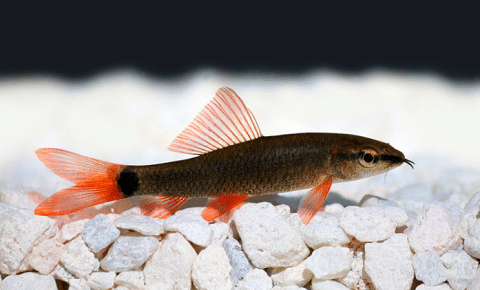
- Scientific Name: Epalzeorhynchos frenatum
- Size: 5 – 6 inches
- Minimum Tank Size: 55 gallons
- Water Temperature: 68 – 78 °F
- pH: 6.5 – 8
- Hardness requirements: 5 – 11 dGH
- Diet: Omnivorous
The rainbow shark is a streamlined species from Asia with a jet-black body and bright red fins. The wild-type fish has bold enough colors, but these fish are also available in an exotic albino form and even Glofish® colors like Cosmic Blue® and Galactic Purple®!
These active fish can make a real statement as a centerpiece fish for larger aquariums, but only when kept with the right companions. They are not really sharks, but they can be pretty aggressive and territorial, so it’s safest to keep just one and avoid any similar tank mates.
6. Black Ghost Knifefish
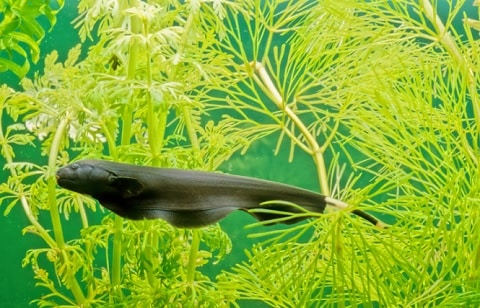
- Scientific Name: Apteronotus albifrons
- Size: up to 20 inches
- Minimum Tank Size: 120+ gallons for adults
- Water Temperature: 75 – 82 °F
- pH: 6.8 – 7.8
- Hardness requirements: 5 – 19 dGH
- Diet: Carnivorous
If you’re looking for a true oddball fish, the black ghost knife fish can make an interesting choice! They are large, nocturnal fish with a very strange, knife-shaped body and the way their fins move as they cruise around their fish tank is truly mesmerizing!
These strange fish use electrical signals to navigate the world around them and they are most active at night. They might not be the fastest fish in the tank, but these guys are predators so its best to keep them with larger and faster tank mates.
7. Geophagus Altifrons
- Scientific Name: Geophagus altifrons
- Size: up to 10 inches
- Minimum Tank Size: 150 gallons
- Water Temperature: 79 – 89 °F
- pH: 5 – 6.5
- Hardness requirements: 10 – 20 dGH
- Diet: Omnivore
If you’re looking for a peaceful centerpiece fish for a large aquarium, Geophagus altifrons might be the perfect choice (video source). This South American cichlid stands out with beautiful glowing colors and long tassel-like extensions from the ends of its fins.
One of the great things about this cichlid (apart from its amazing looks!) is its diet. They feed by filtering the substrate, so they are safe to keep in the same tank with much smaller fish. It’s best to keep these social fish in a school of at least six fish.
8. Fancy Goldfish
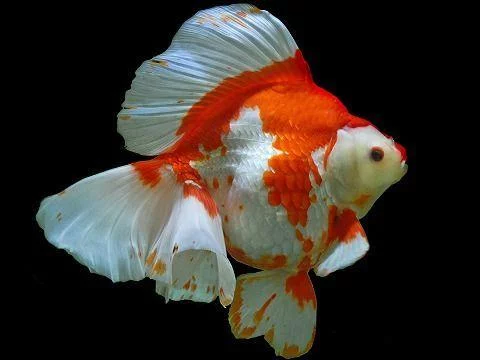
- Scientific Name: Carassius auratus
- Size: 5 – 8 inches
- Minimum Tank Size: 30 gallons
- Water Temperature: 65 – 72 °F
- pH: 7 – 8
- Hardness requirements: 5 – 15 dGH
- Diet: Omnivorous
It’s only right that we wrap up this list of amazing fish with the world’s most popular aquarium species – The good old goldfish!
These fancy goldfish are perfect centerpiece pets for a species only tank, but it is possible to keep them in a peaceful cool-water community tank. Suitable tank mates include small cold hardy fish like zebra danios and white cloud mountain minnows as well as algae eaters like bristlenose plecos and larger fish like dojo loaches.
You might be wondering why the goldfish gets lumped in with large species like severums and ghost knife fish, but many people are surprised to learn that goldfish can reach 8 inches in length. While it’s possible to keep a single goldfish in a 30-gallon aquarium, you’re going to want a 75 gallon or larger for a group of three.
FAQs
What is the most peaceful centerpiece fish?
Considering fish temperament is very important when choosing centerpiece fish for a community aquarium. Gouramis like the honey gourami and the pearl gourami are some of the most peaceful centerpiece fish if kept with the right tank mates.
What are the best centerpiece fish for planted aquariums?
Pretty much every freshwater aquarium fish will thrive in a planted tank, but some species are better choices than others. Colorful schooling species like the larger rainbowfish look amazing in well-planted aquariums.
The only species you really want to avoid when stocking a planted tank are vegetarians like silver dollars and digging fish like larger cichlids that can uproot your plants.
What is the best centerpiece fish for a 55-gallon tank?
The freshwater angelfish ticks all the right boxes when picking a centerpiece fish for a 55-gallon community aquarium. You could keep up to four adult angels in a tank this size with plenty of room for other peaceful fish species like zebra danios or a cardinal tetra school.
What’s a good centerpiece fish?
The perfect centerpiece fish has bright colors, interesting features, and a peaceful nature. Peaceful cichlids make some of the best choices, but its important to match the species to the size of your tank, your water parameters, and the other fish in the aquarium.
What is the best centerpiece fish 20 gal?
It’s hard to beat the betta when choosing a stunning centerpiece fish for a 20-gallon tank. The secret is to keep just one male betta fish with peaceful tank mates like small community fish. Male bettas may fight with similar-shaped or colored fish, so avoid similar species like powder blue gouramis.
What is a medium size fish tank?
29 to 55 gallon aquariums are generally referred to as medium size tanks. Aquariums of this size are ideal starter tanks because they are easy to maintain and there are just so many species that you can keep in them.
Final Thoughts
Well, there you have it fellow fishkeepers, a centerpiece fish for any aquarium size! Buying new fish is a long-term commitment, so it’s worth spending a little extra time researching any species before adding it to your tank. Fortunately, we have in-depth guides on many of the fish mentioned in this article, so go ahead and explore the website for more useful tips and advice.
What’s your favorite freshwater centerpiece species? Let us know in the comments below!
- About the Author
- Latest Posts
I’m thrilled that you found Aquarium Store Depot! Here you’ll find information on fish, aquariums, and all things aquatics related. I’m a hobbyist (being doing this since I was 11) and here to help other hobbyists thrive with their aquariums! I adhere to a high quality Editorial Process and Review products with real life field usage and practical analysis.

